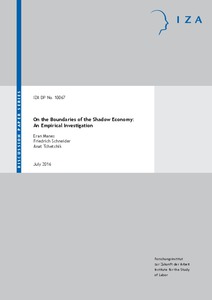On the boundaries of the shadow economy: an empirical investigation
"A large number of empirical studies pointed to the ongoing expansion of the shadow economy in many countries around the globe. A robust finding in these studies is the positive association between unemployment rates and the size of the unofficial sector. However, with consistent estimates of t...
| Main Authors: | , , |
|---|---|
| Institution: | ETUI-European Trade Union Institute |
| Format: | TEXT |
| Language: | English |
| Published: |
Bonn
2016
IZA |
| Subjects: | |
| Online Access: | https://www.labourline.org/KENTIKA-19102933124919201159-on-the-boundaries-of-the-shado.htm |
| Summary: | "A large number of empirical studies pointed to the ongoing expansion of the shadow economy in many countries around the globe. A robust finding in these studies is the positive association between unemployment rates and the size of the unofficial sector. However, with consistent estimates of the size of the unofficial sector only available from the late 1980s, a lack of sufficient time span dictated the use of static models, allowing only a limited understanding of its temporal behavior and interdependence with other covariates. In this paper, we offer a first systematic attempt to estimate the dynamics of the shadow economy, using advanced dynamic panel techniques. Based on insights from a simple job search model of unemployment that features decreasing returns to unofficial activities and congestion effects in job searching, we conjecture a long-run equilibrium relationship between unemployment and the size of the shadow economy. Our empirical model lends strong support to this view. We find that in countries with less stringent job market regulation the long-run impact of Unemployment, the tax burden, and GDP on the shadow economy, while positive and significant, is much smaller than in heavily regulated countries Moreover, the speed of adjustment back to long-run equilibrium following temporary shocks is shown to be three times faster in countries with looser job-market regulation, compared with countries with stricter regulation. These findings have important policy implications." |
|---|---|
| Physical Description: | 37 p. Digital |

